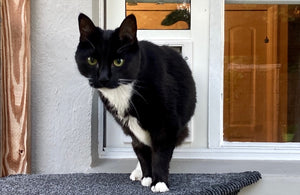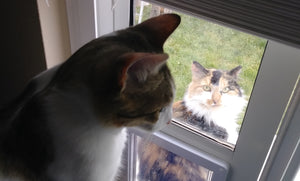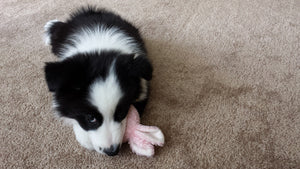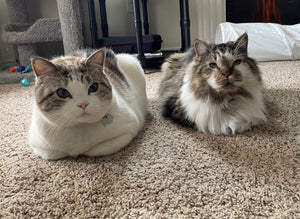How to Clean Your Dog’s Teeth at Home
Cleaning a dog’s teeth is an important part of keeping them happy and healthy. However, oral hygiene is often overlooked as an essential part of a dog’s care routine. Staying on top of your dog’s dental care can help prevent the early onset of canine periodontal diseases, which will often go unnoticed in dogs for many years.
Cleaning a dog’s teeth can feel daunting, so we’ve broken into down into a few easy steps to get you started:
- What you can use to clean your dog’s teeth
- How often should you brush your dog’s teeth
- Training tips for cleaning a dog’s teeth

How to Clean Your Dog’s Teeth
When it comes to cleaning your pup’s teeth, there are plenty of products out there to help with the process. We’ll detail a couple of options so you can decide which is right for you.
Brush Your Dog’s Teeth:
Brushing your dog’s teeth is the most effective way to prevent plaque buildup. Make sure you use toothpaste that is made specifically for dogs. Human toothpaste is made with ingredients that are toxic to dogs. Dog-specific toothpaste will come in yummy (for your dog!) flavors like chicken.
You can buy a dog toothbrush with a handle or one that fits over your finger to use with the toothpaste. A toothbrush with a handle is a good way to go if you have a dog with aggressive tendencies—it’s important to keep your fingers safe during the process! Alternatively, dog toothbrushes that fit over your finger can be easier to maneuver to make sure you reach every tooth while cleaning.
You can also find tooth wipes for dogs that work similarly to a toothbrush but can be more comfortable for dogs who simply won’t accept the toothbrush in their mouth. Although they won’t reach in between teeth, these wipes will allow you to wipe away surface plaque on your dog’s teeth.
Give Your Dog Dental Treats:
Dental treats can supplement your dog’s oral hygiene routine in a fun and yummy way! With the variety of flavors and textures on the market, you can find something your dog will love while also cleaning up their teeth. Chewing in itself is good for your dog’s teeth as it scrapes plaque away manually. Dental chews also contain enzymes that promote dental health. Make sure to read the ingredients and look for natural products with good customer reviews.
If you don’t want to use dental chews, bully sticks, cow ears, and other dog treats are a good option to get your dog chewing and cleaning their teeth. Just make sure to supervise them while they snack on their treat as many dogs get overly excited and swallow the whole thing! Giving a bully stick for just a few minutes at a time throughout the day and then putting it away is a good way to reduce any choking hazard.
Add Cleansing Drops to Your Dog’s Water:
Similar to dental treats, there are water additives you can use that contain cleansing enzymes for your dog’s teeth. Add the recommended amount to your pet’s water bowl and let the drops do the rest! Generally, these will be flavorless so your dog won’t taste any difference in their water.
Look for a reputable brand and retailer for your dog’s dental drops, and make sure ot follow the instructions on the packaging. Also note that this isn’t a replacement for brushing your dog’s teeth, but rather a supplement to improve their overall dental health.
Take Your Dog to the Vet for a Cleaning:
If you simply cannot clean your dog’s teeth on your own, your veterinarian can help you with a professional dental cleaning. This procedure is highly effective as your vet can identify and solve any dental issues going on with your dog. A professional cleaning can often prevent more invasive procedures later on, like needing teeth removed. However, it is also the pricier option and comes along with the risks of putting your dog under. Talk to your vet to see if it’s the right option for your dog.
How Often Should You Brush Your Dog’s Teeth
You should aim to brush your dog’s teeth three times each week. If you can do it every day, even better! But three times a week is the generally agreed-on amount that will maintain your dog’s dental hygiene.
If you have an older dog who has never had their teeth brushed it’s not too late to start. You can start brushing your dog’s teeth at any age to avoid plaque buildup, bad breath, tooth decay, and gum disease.
How to Train Your Dog to Have Their Teeth Cleaned
It’s easiest to train dogs to have their teeth brushed at a young age. When you adopt a new puppy, you’ll be going through basic potty training and accident prevention, so it’s the perfect time to get them used to have their teeth brushed too. You can follow this process to get your dog used to teeth brushing:
- Have your dog sit for a few seconds at a time, raise their gums on either side and gently rub your finger on their gums. Immediately after, give your dog a treat to form a positive association.
- Repeat this process with dog toothpaste on your finger to get them used to the texture and flavor.
- Once your dog is used to your finger, use the toothbrush and repeat this process. Start by just placing the toothbrush on their gums for a second then giving a treat.
- Once your dog is comfortable with the feel of the toothbrush and toothpaste you can try brushing their entire mouth. Keep it quick and be patient. If your dog shows signs of discomfort, pull back and repeat the earlier steps.
- Once you’ve trained your dog to accept brushing, try to brush for one to two minutes per day, or three times a week at the least.
Dental disease can cause serious problems in some dogs, so it’s important to maintain their oral hygiene from puppyhood through adulthood.
We hope this helped explain how you can easily clean your dog’s teeth at home. Looking for some more quick reads? Check out some of our recent articles:





